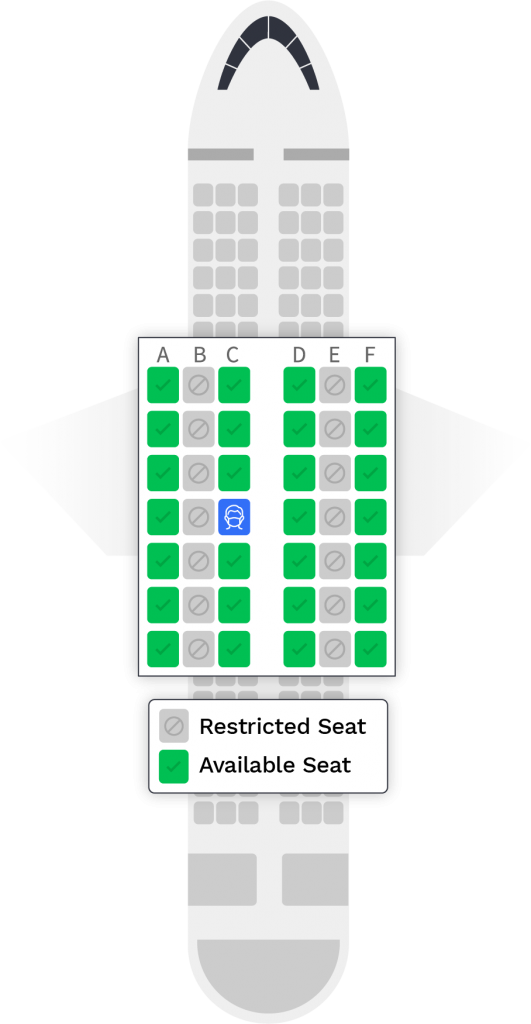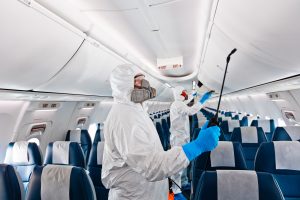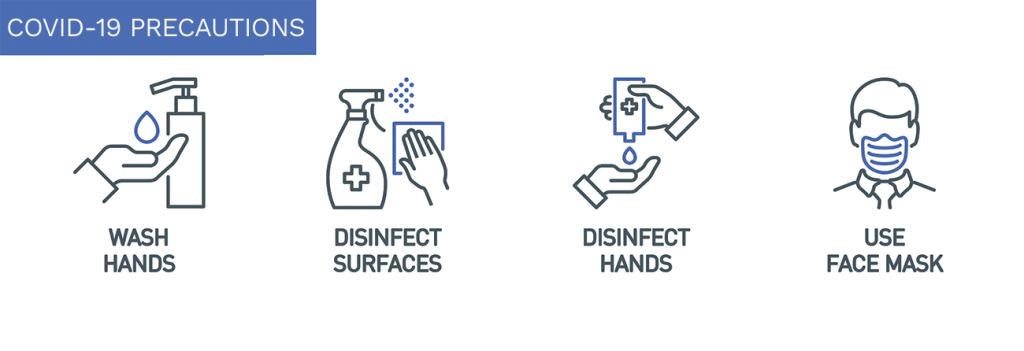Airlines are instituting varying precautions as part of their campaigns to encourage travelers to fly during the pandemic, and to further reduce the risk of COVID-19 transmission. Travelers who understand the effectiveness of each of the precautions are equipped to make informed decisions when assessing the risk of flying. Travelers can also take additional steps to significantly reduce their risk of contracting COVID-19.
The most effective way to reduce the risk of contracting the coronavirus disease (COVID-19) is to simply stay home and not travel. But if travel is necessary, the overall risk of contracting COVID-19 on an airliner is low, and airlines around the world are taking various precautions that can further reduce the risk. These precautions are a key part of their campaigns to get travelers to fly as the COVID-19 pandemic continues, but the effectiveness of these precautions varies, and some airlines have implemented more precautions than others.
No matter how many precautions a traveler or an airline takes, the simple choice to travel will inevitably expose the traveler to more people than staying at home would, and will increase the chance that the traveler comes into contact with somebody spreading COVID-19. Travelers who are familiar with how effective each precaution is can make more informed decisions when evaluating the risk of flying during the pandemic.
Airline Social Distancing Policies Effective at Reducing COVID-19 Risk

Traveling with an airline that encourages social distancing by leaving certain seats unsold on flights will almost certainly reduce a traveler’s risk of contracting COVID-19, despite some airlines insisting otherwise.
The main benefit to social distancing onboard flights is that it reduces the number of passengers onboard the aircraft, thus reducing the chance that an infected passenger is onboard the flight. Such policies also reduce the number of people traveling within three rows of a traveler, where the risk of disease transmission is highest. On a completely full aircraft with a conventional six-abreast seating layout, there will be 41 passengers sitting within three rows of a traveler. On a flight where the airline leaves all middle seats unsold, 14 of those passengers are replaced with empty seats, leaving only 27 other passengers in those crucial rows. The chances that one of those 27 passengers will have COVID-19 is significantly lower than the chances that one of the original 41 passengers will have the disease.
Some airlines have pushed back against the notion that social distancing reduces the risk of COVID-19 transmission in flight and are selling all seats onboard their aircraft. The main motivation for this stance is almost certainly financial; airlines cannot operate a flight profitably at normal airfares if they are only selling a quarter of the seats on the flight. Some airlines that oppose enforced social distancing on flights claim that social distancing onboard is ineffective, noting that passengers on flights with social distancing are still closer than six feet together, the distance recommended by most health authorities. While this is true, these airlines’ logic fails to account for the difference in the overall number of passengers that a traveler will be exposed to on a socially distanced flight compared to a completely full flight.
Airlines Implement Mask Requirements to Reduce Transmission of COVID-19 during Air Travel
Most major airlines are requiring passengers to wear masks or other face coverings at all times onboard their aircraft, which likely reduces the risk of COVID-19 transmission in flight. Some airports have also implemented requirements for face coverings, although such requirements at airports are not as widespread as those on airliners. While wearing a surgical or cloth mask provides little protection for the wearer, health officials have stated that it does reduce the risk of an infected wearer transmitting COVID-19 to another person. Having everybody onboard a flight wear a face covering, therefore, likely reduces the risk that any of them will transmit COVID-19 to another person onboard the flight. The effectiveness of this measure, however, has reportedly been somewhat compromised by poor enforcement and by passengers who wear masks incorrectly.
Some Airlines Have Altered Boarding Processes
Several airlines have altered boarding processes in response to the COVID-19 pandemic; these changes likely reduce the likelihood of COVID-19 transmission onboard by a small amount. The most common change to boarding procedures has been to board the aircraft from the rear to the front, which theoretically reduces the likelihood that travelers seated in different parts of the cabin will come into close contact. In practice, however, passengers’ obedience of boarding processes is imperfect at the best of times, and unfamiliar boarding processes could cause passengers to congregate more at the gate area, negating the benefits of the new boarding process.
Air Travel Industry Boasts of Enhanced Aircraft Cleaning; Science Suggests Low COVID-19 Transmission Risk via Surfaces

Most major airlines have implemented more rigorous standards for cleaning aircraft between flights.
This cleaning has been a major component of most airlines’ marketing campaigns, and rigorous cleaning with disinfectant between flights greatly reduces the chance of transmitting COVID-19 from passengers on a previous flight to passengers on a subsequent flight. Such cleaning, however, does very little to reduce the chances of COVID-19 transmission between passengers on the same flight. The US Centers for Disease Control has also said that COVID-19 transmission through contaminated surfaces “is not thought to be the main way the virus spreads.” Improved aircraft cleaning standards may, therefore, be simply closing off a vector for COVID-19 transmission that was already not a major threat.
Checked Luggage May Not Reduce COVID-19 Exposure Risk
The British government has recommended that passengers check all luggage instead of bringing bags onboard as carry-on luggage. Few other health authorities have issued similar advice, and the logic behind the advice is dubious. While checking luggage may reduce the risk of COVID-19 transmission onboard the aircraft itself by speeding up the boarding process, checking luggage increases the risk of transmission in the airport, as it forces the traveler to stand in another line at the airport and have a sustained face-to-face interaction with at least one other person. The increased risk of COVID-19 from checking the bag at the airport likely outweighs the benefits of the quicker boarding process, especially for travelers who can check in for the flight online and skip the check-in desk completely.
Changes to In-flight Meals and Airport Lounges Only Stem Spread of Coronavirus in Certain Circumstances
Many airlines have scaled back food offerings onboard their aircraft and in their lounges to reduce the risk of COVID-19 transmission. Other airlines have closed their lounges completely in response to the pandemic. These measures likely cut off a potential vector for COVID-19 transmission, as passengers will be touching one fewer thing that has recently been touched by another person and potentially avoiding an enclosed space where people congregate. The benefits of these measures are negated, however, if the traveler compensates for the loss of food at the lounge or on the aircraft by eating at an airport restaurant instead.
Pre-Flight Health Screening Unlikely to Be Effective at Reducing COVID-19 Transmission
Many airlines are requiring passengers to answer a number of questions about their health prior to boarding flights, either via an app or in person. These health screenings are ostensibly intended to prevent passengers with COVID-19 symptoms from boarding a flight, but the screenings are only effective if passengers are completely honest with their replies. Passengers who have mild COVID-19 symptoms may not report such symptoms during screening questions if they fear the airline will not allow them to board the aircraft. Such health screenings are also completely ineffective at discovering passengers with asymptomatic or pre-symptomatic cases of COVID-19.
Several airlines, primarily in the Middle East region, have gone further and are requiring passengers to take COVID-19 tests prior to boarding a flight. Some airlines require certificates of a negative COVID-19 test within a certain time before the flight (usually around two days), while others are requiring COVID-19 tests at the airport. The tests used for the latter, which give results in minutes instead of days, have a false negative rate as high as 50 percent, so they are still an imperfect method for detecting passengers who could spread COVID-19, although they are still more effective than health screening questions.
Air Travel Precautions for Individuals
Travelers can take several additional steps to reduce the risk of contracting COVID-19 during air travel, regardless of what precautions their airline takes. As noted earlier, the risk of contracting COVID-19 in an airport is likely greater than the risk of contracting it onboard the aircraft, so travelers should try to spend as little time in the airport as possible. Travelers can do this by checking in online before arriving at the airport, only bringing carry-on luggage, traveling at off-peak times, and using less-busy security checkpoints if the airport layout allows it. Once past security, travelers can reduce the number of people with whom they come into contact by staying in one location, preferably one with as few people nearby as possible. An empty gate within sight of the gate from which the traveler’s flight is departing is ideal. While at the airport, travelers should avoid shops and restaurants if possible, and should follow strict hygiene precautions, including regular hand washing and use of hand sanitizer. Travelers can also reduce their exposure to other people by taking pre-arranged private transport to and from the airport instead of public transportation.

WorldAware Offers COVID-19 Air Travel Restrictions Report
To help your organization and its personnel stay abreast of the changes in air travel restrictions around the world, WorldAware offers a weekly subscription that provides a list of airlines and related country-level restrictions. Subscribe to the Airline Route Restrictions Report.
COVID-19 Resources
Visit the COVID-19 Risk Intelligence and Resource Center to stay up-to-date with COVID-19 developments around the world.




Leave a Reply